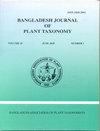Bibliographical note on the syntaxonomy of the vegetation of Tlemcen, Hafir, Moutas and its reserve (North-western Algeria)
IF 0.8
4区 生物学
Q4 PLANT SCIENCES
引用次数: 0
Abstract
This study provides bibliographical note on the syntaxonomy of the vegetation of Tlemcen, Hafir, Moutas of North-western Algeria, including the associations and alliances of the different higher units found in the Hafir forest and the Moutas Reserve. In this work, we observed modifications of forest and pre-forest structures according to bioclimatic variations. However, in this region, the xericity of the climate is not the only factor destroying the plant cover, anthropization is also a degradation factor. While being aware of the negative consequences, man, through their abusive cultivation, illegal logging, overgrazing, urbanization, the depletion of natural resources;, inhibits the evolution of vegetation, participates in the replacement of a rich plant cover by another and more xerophytic plant cover with thorny and/or toxic feature. The landscape is dominated, for the most part, by open and degraded formations based on therophytes and chamaephytes, linked to Rosmarinetea and Cisto-Lavanduletea. The tree structures in Hafir and the Moutas reserve, still occupy only minimal areas subject to the destructive actions of man and his flock. These formations are still linked to the Quercetea ilicis. These ecosystems are marked by a regressive evolution (forest, pre-forest, scrub, scrubland and therophytization). Bangladesh J. Plant Taxon. 27(2): 345-358, 2020 (December)关于特列姆岑、哈菲尔、穆塔斯及其保护区(阿尔及利亚西北部)植被结构的文献注释
本研究提供了关于阿尔及利亚西北部特列姆岑、哈菲尔、穆塔斯植被结构的参考文献,包括在哈菲尔森林和穆塔斯保护区发现的不同高等单位的联合和联盟。在这项工作中,我们观察到森林和森林前结构根据生物气候变化而发生的变化。然而,在该地区,气候的变化并不是破坏植物覆盖的唯一因素,人为化也是一个退化因素。人类在意识到其不良后果的同时,通过滥用耕种、非法砍伐、过度放牧、城市化和自然资源的枯竭;,抑制植被的进化,参与用另一种更具多刺和/或有毒特征的旱生植物覆盖物取代丰富的植物覆盖物。景观在很大程度上由开放和退化的地层所主导,这些地层以与Rosmarinetea和Cisto Lavanduletea有关的兽生植物和变色植物为基础。哈菲尔和穆塔斯保护区的树木结构仍然只占据了受人类及其羊群破坏的极小区域。这些地层仍然与冰栎属有关。这些生态系统的特征是退化进化(森林、森林前、灌木丛、灌木丛和兽藻化)。孟加拉国植物分类学杂志。27(2):345-3582020(12月)
本文章由计算机程序翻译,如有差异,请以英文原文为准。
求助全文
约1分钟内获得全文
求助全文
来源期刊
CiteScore
0.42
自引率
44.40%
发文量
12
审稿时长
6 months
期刊介绍:
Bangladesh is a humid, subtropical country favouring luxuriant growth of microorganisms, fungi and plants from algae to angiosperms with rich diversity. She has the largest mangrove forest of the world in addition to diverse hilly and wetland habitats. More than a century back, foreign explorers endeavoured several floral expeditions, but little was done for non-vasculars and pteridophytes. In recent times, Bangladesh National Herbarium has been carrying out taxonomic research in Bangladesh along with few other national institutes (e.g. Department of Botany of public universities and Bangladesh Forest Research Institute).

 求助内容:
求助内容: 应助结果提醒方式:
应助结果提醒方式:


